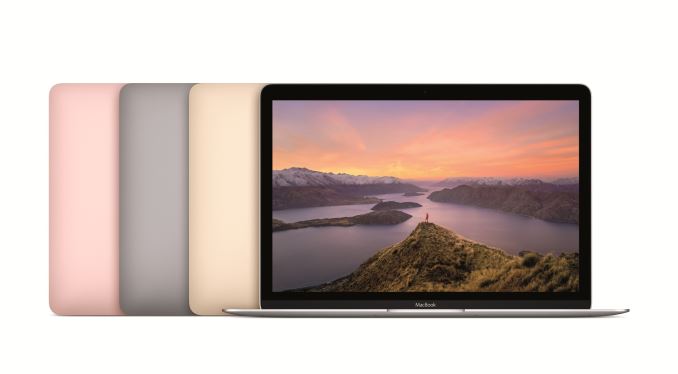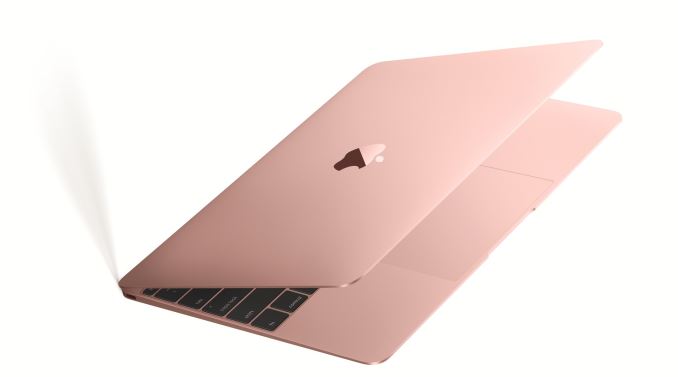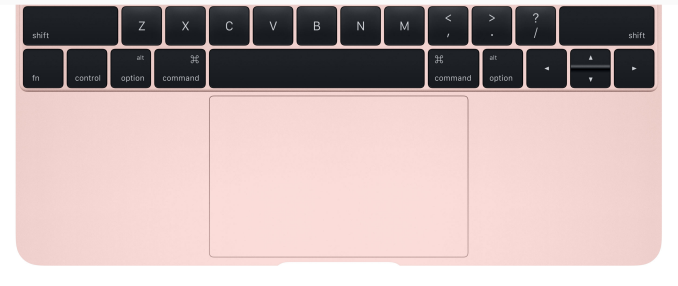Apple Refreshes MacBook with Skylake-based Core M and New Rose Gold Color
by Ian Cutress & Anton Shilov on April 19, 2016 11:10 AM EST
Today Apple has introduced its new generation of its MacBook laptops. On the specification sheets, this generation introduces Intel Skylake based Core m processors, updated integrated graphics, a faster storage solution (either controller or NAND), faster DRAM and bigger batteries. The new notebooks use the same thin chassis and retina-class display as the Broadwell-based MacBooks released last year, but in using the new Skylake silicon the new models are are expected faster and more energy-efficient, and combined with bigger batteries should mean longer battery life. Apple is also expanding the color options, bringing the popular Rose Gold option from the iPhone line to the Macbook.
The new Apple MacBook line is based on the dual-core Intel Core M processors based on the newest Skylake microarchitecture as well as the ninth-generation of Intel's integrated graphics (HD 515, Gen9) with improved media playback support. The new processors are the Core m3-6Y30, the Core m5-6Y54 and the Core m7-6Y75, but are upgraded from their listed base frequencies due to Apple using them in a 'configurable 7W TDP up' mode. This adjusts the base frequency up by 100-200 MHz and offers more TDP headroom for longer turbo periods. The latest microarchitecture and increased frequencies should increase the base performance of the new laptops in general-purpose applications whereas hardware-accelerated playback of HEVC and VP9 video streams should improve battery life in video streaming scenarios. Just like predecessors, the new laptops use 8 GB of memory, using LPDDR3 to minimize power consumption of memory sub-system. This time, Apple uses LPDDR3-1866 memory for its MacBook, which is a tad faster than the LPDDR3-1600 DRAM it used last year. This should have a knock-on effect on the integrated graphics performance as well.
| Apple MacBook Line | |||||||
| 2015 (Broadwell) | 2016 (Skylake) | ||||||
| CPU | SKU | Intel Core M-5Y31 |
Intel Core M-5Y51 |
Intel Core M-5Y71 |
Intel Core m3-6Y30 |
Intel Core m5-6Y54 |
Intel Core m7-6Y75 |
| cTDP Up | 7W cTDP Up | ||||||
| Base | 1.1 GHz | 1.2 GHz | 1.3 GHz | 1.1 GHz | 1.2 GHz | 1.3 GHz | |
| Turbo | 2.4 GHz | 2.6 GHz | 2.9 GHz | 2.2 GHz | 2.7 GHz | 3.1 GHz | |
| GPU | SKU | Intel HD Graphics 5300 (GT2) 24 EUs, Gen 8 |
Intel HD Graphics 515 (GT2) 24 EUs, Gen 9 |
||||
| Base | 300 MHz | 300 MHz | |||||
| Turbo | 850 MHz | 900 MHz | 850 MHz | 900 MHz | 950 MHz | ||
| DRAM | 8GB LPDDR3-1600 | 8GB LPDDR3-1866 | |||||
| PCIe SSD | 256 GB | 512 GB | 256 GB 512 GB |
256 GB | 512 GB | 256 GB 512 GB |
|
| PCIe 2.0 x4 | PCIe 3.0 x2 | ||||||
| Display | 12-inch 2304x1440 IPS LCD | ||||||
| Ports | 1 x USB 3.1 (Gen 1) Type-C 3.5mm combo jack |
||||||
| Network | 2x2:2 802.11ac with BT 4.0 | ||||||
| Battery | 39.7 Wh | 41.4 Wh | |||||
| Dimensions | H: 0.14-0.52-inch W: 11.04-inch D: 7.74-inch |
||||||
| Weight | 2.03 lbs (0.92 kg) | ||||||
| Colors | Space Gray Gold Silver |
Space Gray Gold Silver Rose Gold |
|||||
| Price | $1299 | $1599 | $1749 | $1299 | $1599 | $1749 ? | |
Since the chassis and the monitor essentially remained the same as last year, we are still talking about a machine with 12” IPS display panel with 2304x1440 resolution and a full-size keyboard. The maximum thickness of the new MacBook is 1.31 cm (0.52”) and the weight is 0.92 kg (2.03 pounds), similar to the first-gen model.
Apple claims that the new MacBook laptops feature upgraded solid-state storage, which relies on the PCIe bus, but it offers higher performance than the previous-gen SSD the company used on its 2015 MacBook. Last year the company essentially used its own SSD with its own controller, based on iFixit.com’s findings. Perhaps, this year Apple uses a new-gen SSD design developed in-house. Unfortunately, the company remains tight-lipped regarding the nature of its SSD improvements, but only discloses that they are faster than the predecessors. Last year's MacBook used a PCIe 2.0 x4 NVMe interface - moving to Skylake Core M and the fact that Skylake's PCH supports PCIe 3.0 by default means that the new drive is most likely PCIe 3.0, but we're not sure if it is still x4, or if something else has changed. We are asking about this!
In addition to the new components, Apple also uses larger 41.4-watt-hour lithium-polymer terraced battery, compared to a 39.7 watt-hour battery used on the previous-gen model, which should enable longer battery life. Apple itself declares up to 10 hours of wireless web browsing and up to 11 hours of iTunes movie playback, which is an hour longer than before.
The laptop still features a single USB Type-C port with 5 Gbps transfer rate, which can be used for charging, connection to an external display (up to 3840x2160 resolution at 30 Hz refresh rate is supported) and so on. The notebook also has two microphones, a TRRS connector for headsets and a 480p FaceTime camera. Wireless networking capabilities of the notebook also remained untouched: the notebook supports dual-band 2x2 802.11ac Wi-Fi as well as Bluetooth 4.0.
One element worth noting is that the use of Skylake Core M should open up features such as Speed Shift to Apple, where the system has the ability to respond quicker to CPU demands up to 30x and finish quick tasks faster than the previous generation even recognizes the request for a high-performance mode. This becomes significant for responsiveness and user experience, but Speed Shift requires specific OS support. Intel worked closely with Microsoft to enable it for Windows 10, and at this point Apple has not stated publicly if the new MacBook will support Speed Shift out of the box or will be in a future OS update.
The new Apple MacBook laptops are available from Apple directly starting today and from its partners starting April 20, 2016. The most basic Apple MacBook model with Intel Core m3-6Y30 SoC, 8 GB of memory and 256 GB of solid-state storage costs $1299. The more advanced model featuring the Core m5-6Y54 and 512 GB of storage retails for $1599. The Core m7-based model is built-to-order and its price will be higher although we expect it to be similarly priced to the upgraded Broadwell model.
Source: Apple

















106 Comments
View All Comments
repoman27 - Tuesday, April 19, 2016 - link
It's only $250 to upgrade from m3 to m7, or $150 to go from the m5 to m7. Intel's tray price for the m3 and m5 is $281, and the m7 is $393. Think of it this way, Apple throws in an m5 when you pay $1.17 / GB for NAND. And seeing as it's an in-house designed, just 3 packages on the motherboard, NVMe PCIe x4 solution, that pricing isn't necessarily out of line.Core M is not a cheap platform, and despite what Intel might lead you to believe, there are occasionally other components of value to be found in some PCs.
Samus - Tuesday, April 19, 2016 - link
You are reading the chart wrong Repoman, it's $550 to go from an m3 to an m7 at THE SAME GB NAND level.And as you said, the price difference from Intel is about $112. But Apple is charging $550.
But my point is, why do they even bother with an m3 and m5 model. Other products based on the Core M such as the $500 Surface ONLY come in one variant, the highest speed m7.
star-affinity - Wednesday, April 20, 2016 - link
They draw less power?repoman27 - Wednesday, April 20, 2016 - link
The chart lists the price for the m7 with 512 GB SSD followed by a "?". I looked at the actual pricing on Apple's website. So either way, it's still NOT $550 for the processor upgrade at the same storage levels.The $499 Surface uses an Atom x7 which is not even remotely the same as Core m7. You've confused a $37 part with a $393 part. The $899 Surface Pro 4 comes with a Core m3-6Y30 with a base clock speed of 900 MHz, 4 GB of RAM and a 128 GB SSD (Type Cover sold separately for $160).
The reason why they bother with m3 and m5 is beacause:
a. There is a real price difference to Apple for the components. They can maintain their gross margin while offering this product at a lower price point. The "starting at" price for a product is important both psychologically and in terms of unit sales. This gives them a standard good-better-best marketing strategy.
b. Apple needs to generate enough sales volume for the 12-inch MacBook to justify their investment in R&D, tooling, etc. The 12-inch MacBook includes more innovative technologies, novel manufacturing processes and bespoke components than most OEMs have employed across their entire lines in the past 5 years. Instead of looking at the spec sheet, look at the iFixit teardown of last year's model and compare it to any other PC currently on the market.
c. Apple is a top 5 PC OEM by volume but only has 9 chassis designs in their product stack. Their unit sales for individual models is generally much higher than other OEMs. Intel probably couldn't produce enough of their highest binned SKL-Y dies to feed Apple even if they wanted to.
d. Intel probably isn't interested in allowing Apple to cherry pick their Y series SKUs that hard, and Apple is likely using their broad support of Core M now as leverage.
FrozenGiraffe - Tuesday, April 19, 2016 - link
It is $250, not $550.jasonelmore - Tuesday, April 19, 2016 - link
Intel is charging to much for these chips.. The die is super small, yet they are charging $350-$450 tray price for these tiny tiny chips, that cost them about 10 bucks to make (and thats counting R&D and fab equipment), the wafer is around $3 per square inchjasonelmore - Tuesday, April 19, 2016 - link
before you spout power consumption arguments, of course this is low power, even a bad chip would be low power.. they dont binn these chips, they are all low power. Thats why the M3 vs M7 is only 200Mhz bumpstadisticado - Tuesday, April 19, 2016 - link
$3 per square inch??? You're insane. A 12 inch wafer has ~110 square inches. Your estimate says that wafer only costs $330 to produce.A better estimate for a mature process might be $30 per square inch, and even that might be low for Intel 14nm still.
Samus - Tuesday, April 19, 2016 - link
Even if it costs $330 to produce, it cost billions to tool a production facility. BILLIONS.Dug - Wednesday, April 20, 2016 - link
Why do people that don't know what they are talking about, have this need to prove it online?You have absolutely no idea how much it costs to produce these from start to finish.
You have no idea how much it costs just to tool the machinery.
Do you have any idea how much shipping is, employees, taxes, insurance, etc?
No? I didn't think so, because that is all confidential information.
Most people at Intel don't know, and somehow you do?
And who are you to say they are charging too much? Do you work for a non-profit organization that doesn't actually create anything, so you think everything produced should be free?